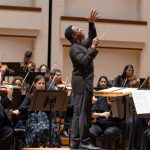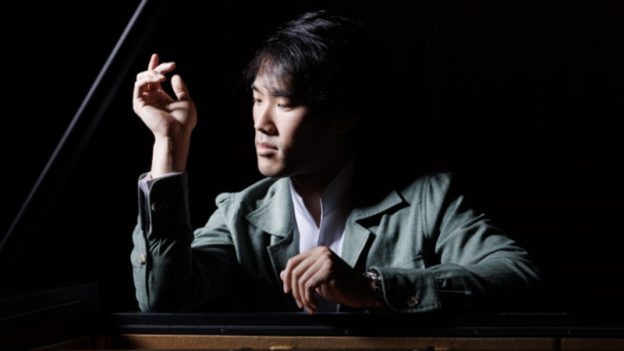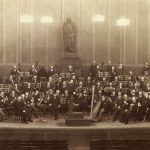Octber 9, 11 & 12, 2025
Meyerson Symphony Center
Dallas, TX – USA
Dallas Symphony Orchestra, Fabio Luisi, conductor; Bruce Liu, piano.
Sophia JANI: What do flowers do at night? (DSO Premiere)
Camille SAINT-SAËNS: Piano Concerto No. 5 in F Major, “Egyptian”
Ottorino RESPIGHI: Le fontane di Roma (“The Fountains of Rome”)
Ottorino RESPIGHI: Vetrate di chiesa (“Church Windows”)
Gregory Sullivan Isaacs | 13 OCT 2025
On Thursday evening, the Dallas Symphony Orchestra gave a concert packed with huge showpieces. The only possible exception was the opening work, a piece by Sophia Jani, the DSO composer-in-residence, entitled What do flowers do at night?
Unfortunately, I can’t tell you much about how this work sounds live because a traffic jam, caused by a festival of some sort in Clyde Warren Park, made me a few minutes late, and I wasn’t allowed in. However, in preparation for reviewing the concert, I listened to a recording on Soundcloud, so these comments derive from that.
Much like the two very colorful works by Ottorino Respighi that closed the program, Jani’s composition tries to describe in music something from nature, namely Selenicereus grandiflorus, called the “Queen of the Night.” It is a night-blooming and climbing cactus, with a strong scent of vanilla, that you can view here, on YouTube, from start to finish:
Jani writes in a modernist, non-traditional voice that creates a series of musical events with a cumulative effect. The opening half is the most effective. We hear a series of arching motives that perfectly describe the gradual opening of the flower.
Next was Camille Saint-Saëns’ Piano Concerto No. 5 in F major, Op. 103, “The Egyptian,” with the nimble-fingered young pianist Bruce Liu, winner of the 2021 Warsaw Chopin Competition, as soloist.
Saint-Saëns wrote this concerto for himself to play as soloist at a “Jubilee” concert celebrating the 50th anniversary of his debut.
Music director Fabio Luisi and the orchestra stepped back, allowing Liu to be the star of the performance, taking full advantage of all of the technical fireworks Saint-Saëns packed into the piece. The audience loved it and responded enthusiastically.
The orchestra stepped into the spotlight for the second half of the program with two orchestral showpieces by Ottorino Respighi. While his musical style was progressive, he never approached the atonality popular at the time. Instead, he incorporated tonal influences from the Middle Ages, the Renaissance, and the Baroque, combining them into an original take on impressionism.
Respighi’s splashy Fountains of Rome is one of the outstanding examples of painting a picture, an impression, with music. A perfect example is the pastoral opening of “The Fountain of Valle Giulia at Dawn,” where he uses the oboe to imitate the shepherd’s shawm.
It was an excellent performance. Luisi gave the orchestra the freedom to express all of the pictorial aspects of their musical passages, while keeping the music moving forward.
The final work on the program was more Respighi, his four symphonic impressions, Vetrate di Chiesa (“Church Windows”). Three of these were based on his earlier piano pieces, Tre preludi sopra melodie gregoriane for piano, which were based on fragments of medieval Gregorian Chant. However, Respighi’s almost magical ability to write for orchestra belies their more humble beginnings.
Once again, Luisi and the orchestra maximised Respighi’s music, especially his decorative use of percussion, piano, harp, and even celeste, to add shimmer as well as its more usual role to add drama. But there was no lack of drama when the Lay Family Organ was called into service.
Overall, this was also an excellent performance, but it suffered from over-programming. Although many orchestral concerts can successfully feature multiple Respighi tone poems, this time, these two works, one right after the other, felt like an abundance. ■
EXTERNAL LINKS:
- Dallas Symphony Orchestra: dallassymphony.org
- Fabio Luisi: fabioluisi.com
- Sophia Jani: hsophiajani.com
- Bruce Liu: bruce-liu.com

Read more by Gregory Sullivan Isaacs.
RECENT POSTS
 Kwamé Ryan and the Charlotte Symphony, with violinist Gil Shaham, deliver a rapturous all-Tchaikovsky evening • 11 Oct 2025
Kwamé Ryan and the Charlotte Symphony, with violinist Gil Shaham, deliver a rapturous all-Tchaikovsky evening • 11 Oct 2025 Equilibrium and elegance: Dover Quartet and de Guise-Langlois find balance in Haydn, Jalbert, and Mozart • 10 Oct 2025
Equilibrium and elegance: Dover Quartet and de Guise-Langlois find balance in Haydn, Jalbert, and Mozart • 10 Oct 2025




.png)